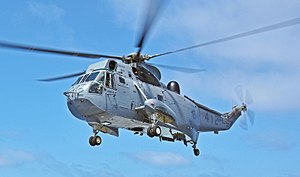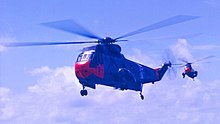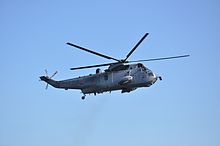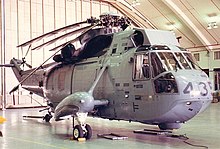
The Kaman SH-2 Seasprite is a ship-based helicopter originally developed and produced by American manufacturer Kaman Aircraft Corporation. It has been typically used as a compact and fast-moving rotorcraft for utility and anti-submarine warfare (ASW) missions. Early on it was modest sized single-engined naval utility helicopter, and progressed to twin-engine ASW and SAR, and the latest model served well into the 21st century, with G model in active service in the 2020s with Egpyt, New Zealand, Peru, and Poland.

The Sikorsky SH-3 Sea King is an American twin-engined anti-submarine warfare (ASW) helicopter designed and built by Sikorsky Aircraft. A landmark design, it was one of the first ASW rotorcraft to use turboshaft engines.

HMCS Bonaventure was a Majestic-class aircraft carrier, the third and last aircraft carrier in service with Canada's navy. The aircraft carrier was initially ordered for construction by Britain's Royal Navy as HMS Powerful during the Second World War. Following the end of the war, construction on the ship was halted and it was not until 1952 that work began once again, this time to an altered design for the Royal Canadian Navy. The ship entered service in 1957 renamed Bonaventure and, until the vessel's decommissioning in 1970, was involved in major NATO fleet-at-sea patrols and naval exercises and participated in the Cuban Missile Crisis. During her career Bonaventure carried three hull identification numbers, RML 22, RRSM 22 and CVL 22. Following her decommissioning Bonaventure was sold for scrap and broken up in Taiwan.

The Royal Canadian Navy is the naval force of Canada. The navy is one of three environmental commands within the Canadian Armed Forces. As of February 2024, the RCN operates 12 Halifax-class frigates, 12 Kingston-class coastal defence vessels, 4 Victoria-class submarines, 2 Harry DeWolf-class offshore patrol vessels, 8 Orca-class patrol vessels, and several auxiliary vessels. The RCN consists of 8,400 Regular Force and 4,100 Primary Reserve sailors, supported by 3,800 civilians. Vice-Admiral Angus Topshee is the commander of the Royal Canadian Navy and chief of the Naval Staff.
The history of the Royal Canadian Navy goes back to 1910, when the naval force was created as the Naval Service of Canada and renamed a year later by King George V. The Royal Canadian Navy (RCN) is one of the three environmental commands of the Canadian Forces. Over the course of its history, the RCN has played a role in the First World War, contributed significantly to the Battle of the Atlantic during the Second World War, and was a part of NATO's force buildup during the Cold War. In 1968, the RCN was amalgamated with the Canadian Army and the Royal Canadian Air Force to form what is today the unified Canadian Armed Forces. The naval force was known as Maritime Command until 2011, when the environmental command was renamed as the Royal Canadian Navy.

Shearwater Heliport, formerly known as Canadian Forces Base Shearwater and commonly referred to as CFB Shearwater and formerly named HMCS Shearwater, is a Canadian Forces facility located 4.5 nautical miles east southeast of Shearwater, Nova Scotia, on the eastern shore of Halifax Harbour in the Halifax Regional Municipality. Following a base rationalization program in the mid-1990s, the Canadian Forces closed CFB Shearwater as a separate Canadian Forces base and realigned the property's various facilities into CFB Halifax. These include:

The Sikorsky H-19 Chickasaw is a multi-purpose piston engined helicopter that was used by the United States Army and United States Air Force. It was also license-built by Westland Aircraft as the Westland Whirlwind in the United Kingdom. United States Navy and United States Coast Guard models were designated HO4S, while those of the U.S. Marine Corps were designated HRS. In 1962, the U.S. Navy, U.S. Coast Guard and U.S. Marine Corps versions were all redesignated as H-19s like their U.S. Army and U.S. Air Force counterparts.

The Sikorsky CH-148 Cyclone is a twin-engine, multi-role shipborne helicopter developed by the Sikorsky Aircraft Corporation for the Canadian Armed Forces. A military variant of the Sikorsky S-92, the CH-148 is designed for shipboard operations and replaced the CH-124 Sea King, which was in Canadian Armed Forces operation from 1963 to 2018.

A helicopter hauldown and rapid securing device (HHRSD) or beartrap enables the landing and handling of helicopters and unmanned aerial vehicles (UAVs) aboard small ships in poor weather. Similar systems include Recovery Assist, Secure and Travers (RAST) and TRIGON.

Canadian Forces Base Greenwood, or CFB Greenwood, is a Canadian Forces Base located 1.5 nautical miles east of Greenwood, Nova Scotia. It is primarily operated as an air force base by the Royal Canadian Air Force and is one of two bases in the country using the CP-140 Aurora and CP-140A Arcturus anti-submarine/maritime patrol and surveillance aircraft. Its primary RCAF lodger unit is 14 Wing, commonly referred to as 14 Wing Greenwood.

406 "City of Saskatoon" Maritime Operational Training Squadron is a Royal Canadian Air Force (RCAF) unit of the Canadian Armed Forces. Based at 12 Wing Shearwater since 1972, it is responsible for crew training on the Sikorsky CH-148 Cyclone since summer of 2016. The squadron was formed during World War II as part of RAF Fighter Command.

The St. Laurent-class destroyer was a class of destroyer escorts that served the Royal Canadian Navy and later the Canadian Forces from the mid-1950s to the mid-1990s.

In the Canadian Forces, Maritime Forces Atlantic (MARLANT) is responsible for the fleet training and operational readiness of the Royal Canadian Navy in the Atlantic Ocean and Arctic Ocean. It was once referred to as Canadian Atlantic Station.

Canadian Armed Forces Search and Rescue is the collective name used to refer to search and rescue (SAR) resources and operations within the Canadian Armed Forces (CAF). The Royal Canadian Navy (RCN) and Royal Canadian Air Force (RCAF) are jointly responsible for Canada’s SAR operations.

443 Maritime Helicopter Squadron is a Canadian Armed Forces helicopter squadron under the Royal Canadian Air Force (RCAF), located on Vancouver Island, British Columbia. It was originally a Second World War RCAF squadron that operated as part of RAF Fighter Command in Europe with the Supermarine Spitfire.

423 Maritime Helicopter Squadron is a unit of the Canadian Forces under Royal Canadian Air Force. It currently operates the Sikorsky CH-148 Cyclone from CFB Shearwater in Nova Scotia, Canada.

The Shearwater Aviation Museum is an aviation museum located at CFB Shearwater in Shearwater, Nova Scotia. The museum acquires, conserves, organizes, researches and interprets to Canadian Forces personnel and the public at large for their study, education and enjoyment, artifacts and documents which exemplify the history of Canadian maritime military aviation.
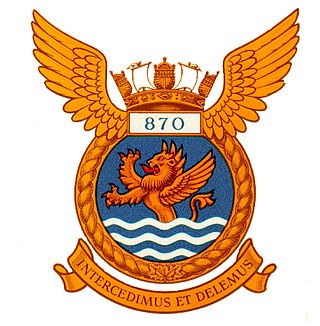
870 Naval Air Squadron, also known as VF-870, was a squadron of the Royal Canadian Navy (RCN). It was formed when 803 Naval Air Squadron of the Royal Navy was renumbered to 870 NAS on 1 May 1951. It operated throughout the 1950s and early 1960s before disbanding on 7 September 1962. It was the first RCN squadron to operate jet aircraft.
